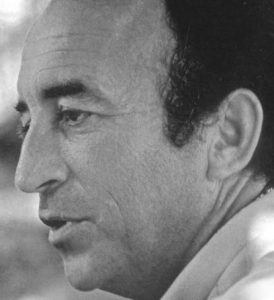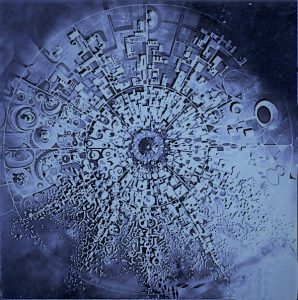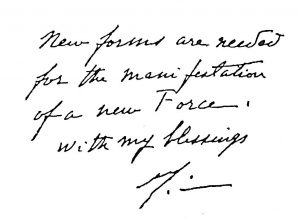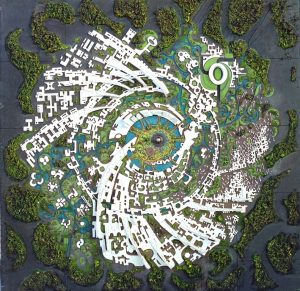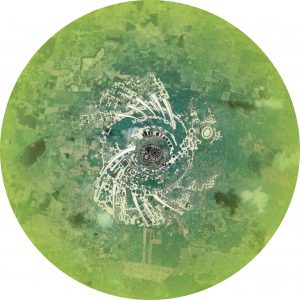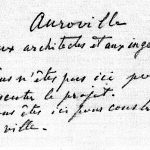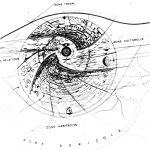UNESCO Presentation by Roger Anger
Architect-Speak
Excerpts from a talk by Roger Anger, at the UNESCO Conference in Paris, November 1966, soon after the Nebula plan was made. It marks the vision, process and guiding definitions of urbanism that already went into this “work in progress.” In the Macrostructure that followed in 1967, the idea of an Agricultural Zone was first introduced by the architect. This was finalized as the greenbelt in the Galaxy plan approved in January 1968 and presented in the land layout under the banyan tree on February 28, 1968.
The original French version of the talk is attached.
So after what Mr Poushpa Dass* just told you it is up to my friends and myself to present Auroville along those general lines and to make you penetrate its universe of hope; an attempt to share the deep faith that we all have in its realization and our conviction to work for an universal work necessary for a world in full evolutionary crisis. But our enthusiasm does not prevent us to be realistic, concrete, to have our feet on earth and not in the sky, to measure the difficulties and sometimes, to see them more lucidly than the professionals of scepticism…
– – – –
Auroville, as Mr Poushpa Dass just said, will be built in India on a territory of 20 sq. km, a few kilometres north of Pondicherry, in the state of Madras, on an almost uncultivated land, in a nature coloured and generous, not far from the sea. Its construction will spread across 15 years. The laying of the foundation stone is planned for February 1968.
From this angle, Auroville has nothing to retain our attention. The construction of a new town has become less exceptional today and has lost the interest it could elicit at the time of Chandigarh and Brasilia…
However, what makes Auroville different from other cities to be built and to build, is truly speaking, its programme, its aim, its role.
Ordinary towns do not propose anything else other than the opposite, namely: individual and exclusive materialism. By its conception as an international centre, by its character as a laboratory at the scale of the planet, Auroville will in fact represent the image of human fraternity, the draft of the first city of world citizens.
Seeing the ambition of such a project, it is necessary, I believe, to place it briefly in its context, and to speak of the vision of the founders in the traditional sense in the West.
How, why is Auroville born?
The task to give a concrete form to the vision of Sri Aurobindo, as Mr Poushpa Dass just explained, has been given to the Mother: the creation of a new world, of a new society, expressing and incorporating a new consciousness to the work she has initiated. By the very nature of things it is a collective ideal calling for a collective effort to be realised in the terms of a research in human perfection; the Ashram, founded and developed by the Mother has been the first step towards the accomplishment of this goal. The project of Auroville is the next step, attempting to widen the base and trying to establish the harmony between spirit and matter in the collective life of humanity; also, the teaching of Sri Aurobindo is deeply experimental and contrary to the passive renunciation of life of the traditional yoga of India; matter should be used, transformed and prove that spirituality is not incompatible with the utilisation of the most modern technique, the experience proving that the present society tends to die by its own development – a certain sign that there is a radical defect in its system, the proof, also, that its conception of man and its method of development does not correspond to the integral reality of the human being, nor to the aim of life that this reality calls for. Its quest for super humanity proposes to the mad reasonable men we pretend to be, the reasonable folly of a world to be transfigured here and now.
Auroville, then, appears like an attempt to realize, through work and actions in this material world, the vision of Sri Aurobindo.
Auroville becomes a field of experiments, of a research of the truth: not for any individual salvation, nor for any selfish nirvana but at the service of men of all the countries of the world. Auroville widens its conception of a model life to the dimensions of a universal life and, such a programme, if it may look utopian to many, remains necessarily an obligation which must rapidly reach realization today.
Numerous attempts of cities have been dreamed in the past: builders on paper or on land since Plato, Aristotle, Augustine, Thomas Moore, the Guarannis towns, the phaianstère attempts – one cannot quote all of them – each of these projects was also animated by a faith in the belief in the industrial city. Why have they failed? Because, most probably, the theories could not be transposed in the real, in the evolutionary state of the society of the time, incapable to understand or sustain such an enterprise.
The consciousness of people today, is luckily very different – supported by international institutions like UNESCO, helped by nations conscious of the role of such a project and made possible by technical, industrial and material means of our civilization – the secret dream of men of goodwill becomes today possibly, a reality.
Auroville which will bear the name of Sri Aurobindo will then be a universal centre whose programme comprises 4 principle zones:
- A residential zone, including urban functions
- A cultural zone with faculties of international renown, institutes of research, scientific foundations, peaceful application of present science. (This zone will include will include the most complete sport installations in order to balance body and soul.)
- An industrial Zone, able to provide the proper needs of Auroville, but also to play a pilot role in the development of the region of South India.
- An international zone constituted by international pavilions, truly embassies of culture, place of meeting, exchange, facilitating a mutual comprehension by the knowledge of problems proper to each country.
Such a programme explains sufficiently how Auroville differs from ordinary cities. Open to all people of goodwill from all races, colour, religion, desiring to participate in an experience never attempted before, its face (or form) will be new and specific. It is then becomes important to underline one of its realities: In which way will Auroville be experimental?
It will be limited to 50,000 residents, because of the experience to be attempted. This number represents the conditions requested, sufficient and necessary for an urban structure where things could play, put themselves in place and evolutionary problems of a collective ideal and collective effort be studied as a basis of the harmony to be realised.
Auroville will then be experimental by the novelty of attempting new relations between Aurovilians, by its new social order, by the importance given to liberty, by building a relationship of emulation: to do one’s best and of collaboration, a real fraternity and absence of social classes – all these considerations condition the internal and physical organization of the town and its contact with the outside.
It would be experimental by its economic role and by its participation via its own means as a model through the development of the arid surrounding region at the agricultural and industrial level.
It will be experimental by the freedom and possibility that she will offer to its inhabitants to have access to the most open culture of the spirit and body.
It will be experimental by its principle of financing, as it would be ensured on top of the proper funds of the SAS by funds and donations, by an international participation in the Cultural Zone, through personal contributions by people desiring to retire in the residential zone and last, by international bank loans for industrial investment and urban infrastructure.
It will be experimental by its urbanism and architecture: this is what interests us the most and concerns us the most directly.
Deliberately fixed at a maximum population of 50000 residents, this limit permits us to adopt an urban circular plan which could not have been possible for a town in continuous expansion.
In the case of Auroville, the inherent advantages of the circular plan find their full justification in accentuating the symbolic character attempted by the city: general unity, facilitates internal circulation and human contact. The axis of penetration towards the centre creates a convergence, a densification of buildings which increases until the moment it reaches the open spiritual centre of the town : the Matrimandir.
From here the different principles of fundamental urbanism take place.
- An evolving macrostructure
- Zones of contrasting densification
- Restructuring of the landscape
- Integration of nature
- Rehabilitation of the street
- Suppression of the automobile obsession
- Research of architectural variety, the most open and the most free.
All the above principals are conditioned and voluntarily directed towards a harmonious relation of people in the city.
The urban plan that has been presented here is only a work in progress.*2 Studies will keep evolving until Auroville finds its final aspect.
In fact, how can we fix, hastily or graphically, without fear of error, the details of its form by the challenge posed by its aim, it is difficult to create such a model city. By competitions open to architects and technicians or people of goodwill Auroville can only be done with the support of all, and the maturity of the problems to be solved will justify the time needed.
The basic team that we are putting together along with Indian technicians remains open for a wide collaboration to realize the birth of Auroville, an experimental, model town as the Mother of the Sri Aurobindo Ashram described it, where all men of goodwill with a sincere aspiration can live freely like citizens of the world, a place of peace, concord and harmony where all warring instincts of man will be utilized to surmount the causes of suffering and ignorance and triumph over one’s limitations and incapacities, a place where relations between people, ordinarily based on competition and strife will be replaced by a spirit of emulation to do well and of collaboration and a real fraternity.
*1 Cultural Attaché, Indian Embassy, Paris
*2 Nebula Model, 1966
Published in: L’informations des Batiments, PARIS No. 7-8 / July-August 1967
